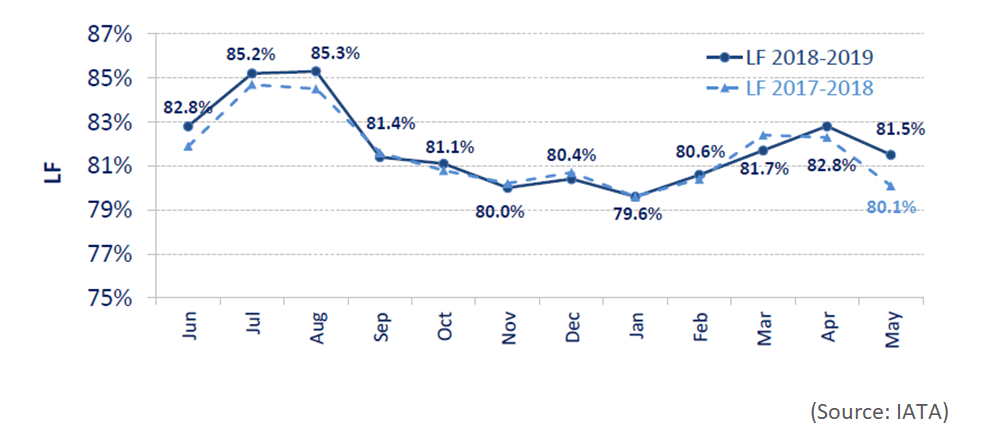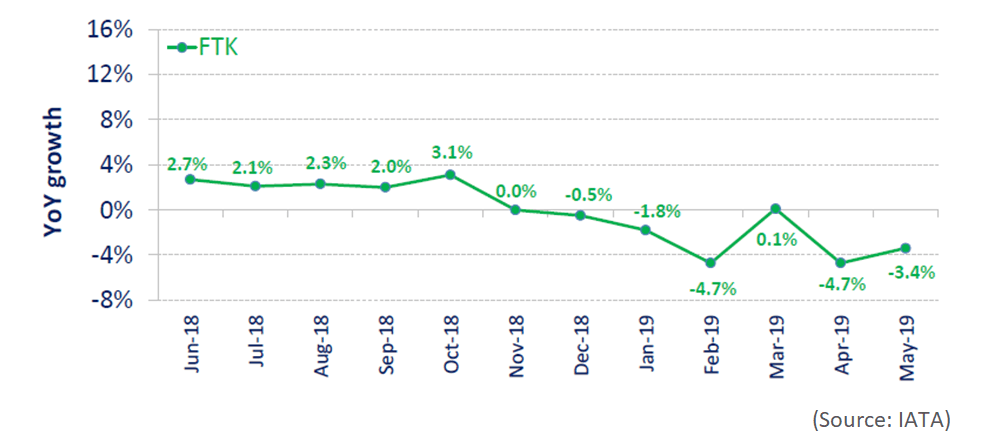The air transport industry is not only a vital engine of global socio-economic growth, but it is also of vital importance as a catalyst for economic development. Not only does the industry create direct and indirect employment and support tourism and local businesses, but it also stimulates foreign investment and international trade.
Informed decision-making is the foundation upon which successful businesses are built. In a fast-growing industry like aviation, planners and investors require the most comprehensive, up-to-date, and reliable data. ICAO’s aviation data/statistics programme provides accurate, reliable and consistent aviation data so that States, international organizations, aviation industry, tourism and other stakeholders can:
-
- make better projections;
- control costs and risks;
- improve business valuations; and
- benchmark performance.
The UN recognized ICAO as the central agency responsible for the collection, analysis, publication, standardization, improvement and dissemination of statistics pertaining to civil aviation. Because of its status as a UN specialized agency, ICAO remains independent from outside influences and is committed to consistently offering comprehensive and objective data. Every month ICAO produces this Air Transport Monitor, a monthly snapshot and analysis of the economic and aviation indicators.
ECONOMIC DEVELOPMENT – July 2019
World Results and Analyses for May 2019
Total Scheduled Services (Domestic and International)
![]()
Revenue Passenger-Kilometres – RPK
World passenger traffic grew by +4.5% YoY in May 2019, +0.2 percentage point higher than the growth in the previous month. Although there was a slight improvement, this growth remained to be one of the weakest performances in the last five years. Both Europe and the Middle East posted a slowdown, with the latter experiencing a negative growth, reflecting changes in the airline business in the region. Russian Federation recorded the fastest domestic traffic growth, followed by China and Japan.

International Traffic vs. Tourist Arrivals
International passenger traffic grew by +4.3% YoY in May 2019, -0.8 percentage point lower than the growth in the previous month. Latin America/Caribbean, Asia/Pacific, and Africa accelerated in traffic growth. Europe, however, experienced the biggest deceleration, followed by the Middle East which became the slowest growing region.
The growth of international tourist arrivals* remained relatively stable.
![]()
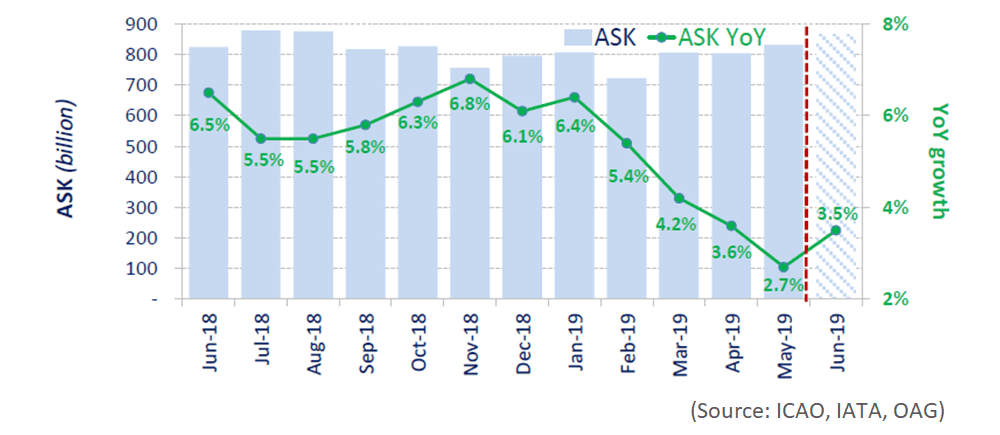
Available Seat-Kilometres – ASK
Capacity worldwide increased by +2.7% YoY in May 2019, -0.9 percentage point lower than the growth in the previous month (+3.6%). According to the airline schedules, capacity expansion is expected to rise up to +3.5% in June 2019.
Load Factor – LF
The passenger Load Factor reached 81.5% in May 2019, -1.3 percentage points lower than the LF recorded in the previous month. As traffic growth outpaced the capacity expansion, the May LF was +1.4 percentage points higher compared to the rate in the same period of 2018.
Freight Tonne-Kilometres – FTK
World freight traffic reported a decline of -3.4% YoY in May 2019, +1.3 percentage points higher than the growth in the previous month. Freight traffic started to trend downwards since the end of last year, except for a short-lived growth in March. All regions posted negative growth, except for Africa and Latin America/Caribbean. Africa outperformed other regions, followed by Latin America/Caribbean, albeit with a slight slowdown. Freight growth remained depressing, affected by the global trade tensions. The most significant fall was observed in the Middle East and Asia/Pacific, which together accounted for almost half of world air freight traffic volume.

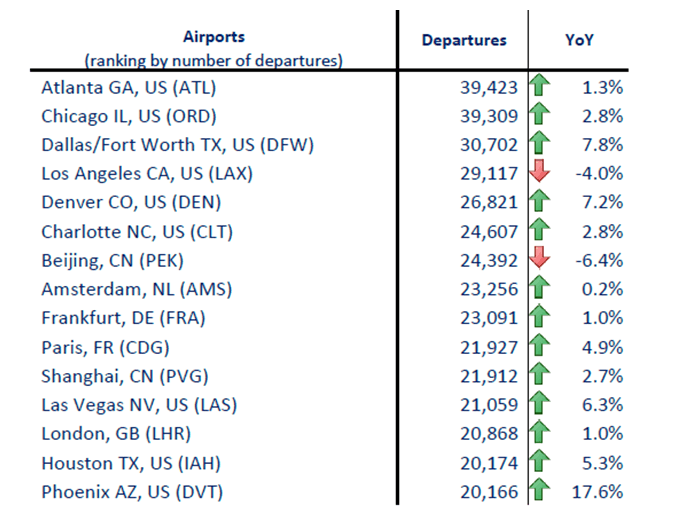
In terms of aircraft departures, the Top 15 airports reported a growth of +2.9% YoY. Thirteen out of the Top 15 airports posted YoY increases. Atlanta remained at 1st with a modest growth of +1.3%. The strongest growth in operations was recorded by Phoenix at +17.6%, followed by Dallas/Fort Worth at +7.8%.

In terms of passengers, the Top 15 airports reported a growth of +3.2% YoY. All the Top 15 airports posted YoY increases, except for Beijing and Tokyo with a decline of -1.4% and -2.6%, respectively. Atlanta remained 1st with a growth of +3.7%. The highest growth was reported by Dallas/Fort Worth at +9.9%, followed by Denver at +9.6%.
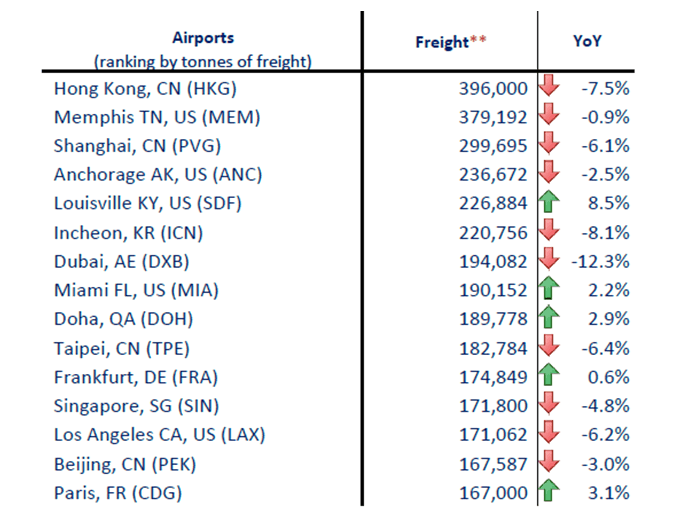 In terms of freight, the Top 15 airports reported a decline of -3.2% YoY. Ten out of the Top 15 airports posted YoY declines, mostly in Asia/Pacific and North America. The sharpest decrease was posted by Dubai (-12.3%), followed by Incheon (-8.1%) and Hong Kong (-7.5%). Louisville outperformed the other major freight hubs and was up by +8.5%.
In terms of freight, the Top 15 airports reported a decline of -3.2% YoY. Ten out of the Top 15 airports posted YoY declines, mostly in Asia/Pacific and North America. The sharpest decrease was posted by Dubai (-12.3%), followed by Incheon (-8.1%) and Hong Kong (-7.5%). Louisville outperformed the other major freight hubs and was up by +8.5%.
MAY 2019: +5.0% YoY in terms of RPK for the Top 15
In terms of RPK, the Top 15 airline groups accounted for 48.7% of world total RPK in May 2019 and grew by +5.0% YoY. This growth was +0.5 percentage point higher than the world average on scheduled services. Twelve out of the Top 15 airline groups posted YoY increases.
For the third consecutive time, Delta ranked 1st with a solid growth of +7.0%, followed by United, rising at +4.3% YoY. American continued to be 3rd with a marginal growth of +0.8%. Southwest slipped by –0.8% and remained at 10th.
Emirates continued to trend downwards with a negative growth of -9.5% and dropped by 2 positions to 8th. Qatar recorded the highest growth among the Top 15 airlines for the second time this year, at a staggering +18.6% albeit, remained at 13th.
Lufthansa and AF-KLM grew modestly by +5.8% and +4.8%, and remained 4th and 5th, respectively. IAG recorded a solid growth at +6.0% and elevated by 1 position to 6th. Ryanair posted the second-highest growth among the Top 15 at +12.5% albeit remained at 12th. Turkish Airlines remained unchanged and retained its position.
China Southern recorded a solid growth at +9.5% and ranked 1 position up to 7th. Air China, China Eastern and Singapore Airlines grew solidly by +8.4%, +11.4% and +8.0%, and remained at 9th, 11th and 15th, respectively.

Worldwide capacity expanded by +2.7% YoY in May 2019. All regions posted a slowdown in capacity expansion, except for minor acceleration in the Asia/Pacific. Despite the deceleration, Europe continued to be the fastest-growing region. For the second consecutive month, the Middle East was the only region posting negative capacity growth resulting in an unchanged YTD capacity expansion, the slowest among all regions.
Acronyms: ACI: Airports Council International; ASK: Available Seat-Kilometres; IATA: International Air Transport Association; FTK: Freight Tonne-Kilometres; LF: Passenger Load Factor;
OAG: Official Airline Guide; RPK: Revenue Passenger-Kilometres; UNWTO: World Tourism Organization; YoY: Year-on-year; YTD: Year-to-date.


